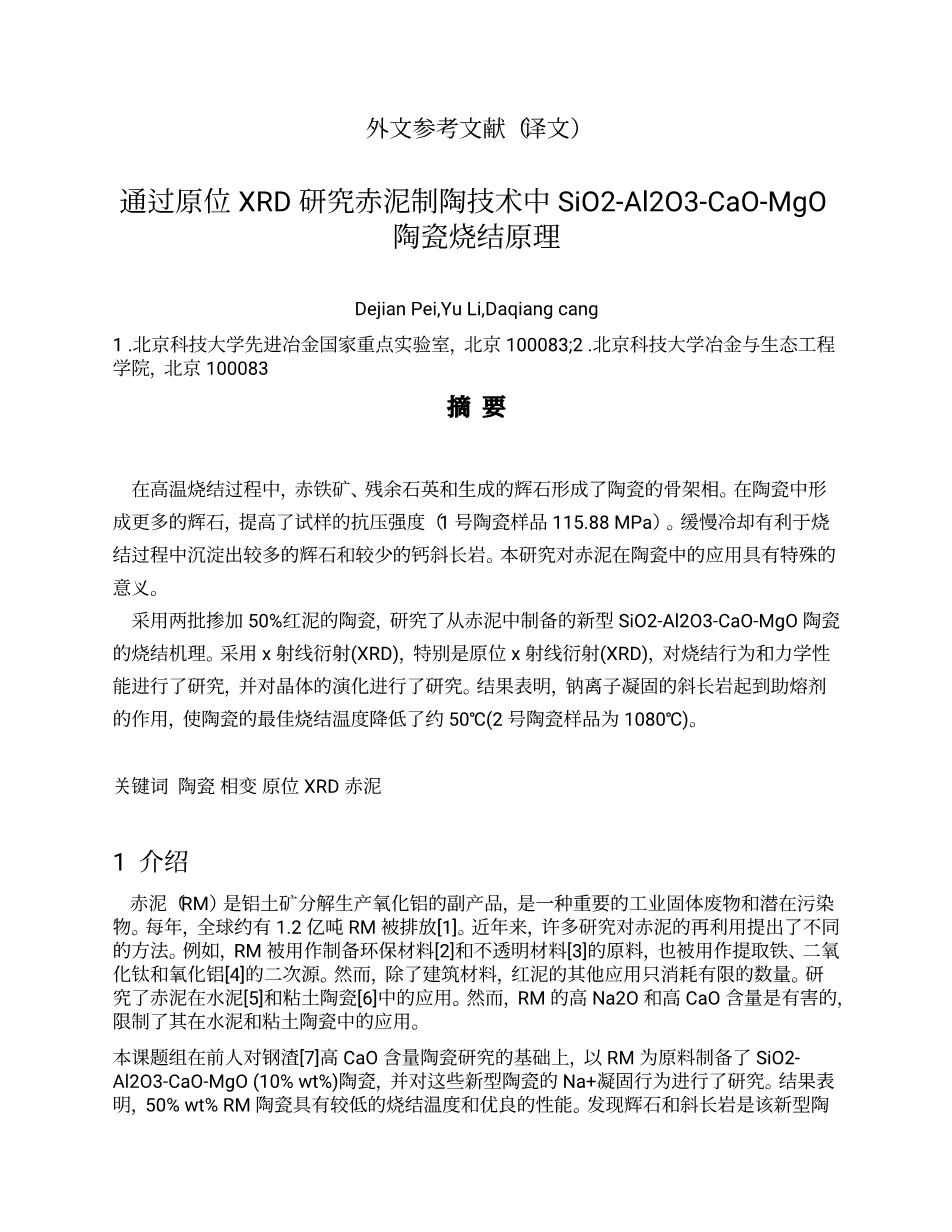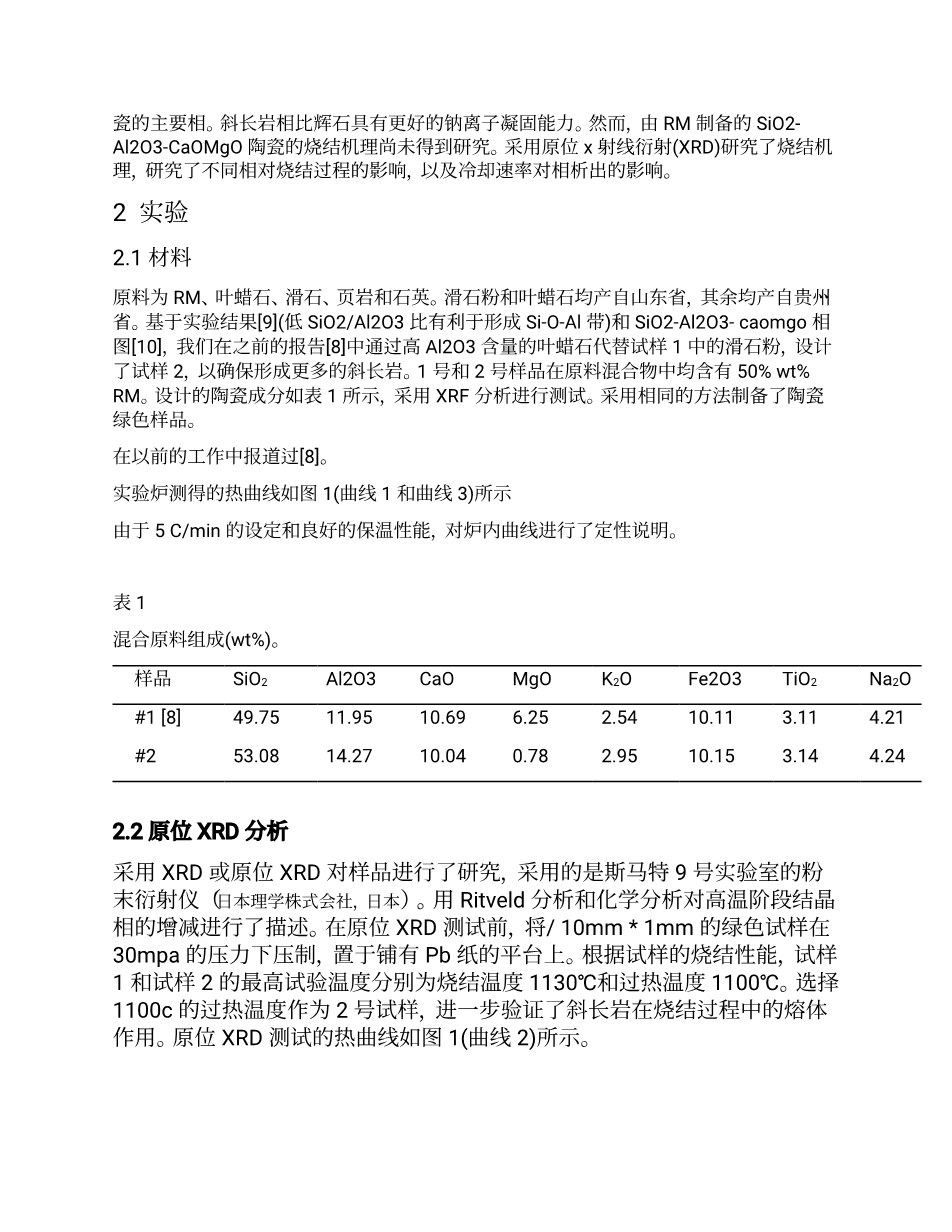In situ XRD study on sintering mechanism of SiO2-Al2O3-CaO-MgO ceramics from red mud
Dejian Pei b, Yu Li a,⇑, Daqiang Cang a,b
Keywords: Ceramics Phase transformation In situ XRD Red mud | hematite, residual quartz, and generated pyroxene formed the skeleton phase in ceramics during high temperature sintering. Formation of more pyroxene in ceramics improved the bending strength (115.88 MPa for ceramic sample #1). Slow cooling was beneficial to precipitate more pyroxene and less anorthite during sintering. This research is of special interest for the utilization of red mud in ceramics. 2019 Published by Elsevier B.V. |
a State Key Laboratory of Advanced Metallurgy, University of Science and Technology Beijing, Beijing 100083, China b School of Metallurgical and Ecological Engineering, University of Science and Technology Beijing, Beijing 100083, China
a r t i c l e | i n f o | a b s t r a c t |
Article history: Received 17 September 2018 Received in revised form 19 December 2018 Accepted 3 January 2019 Available online 9 January 2019 | The sintering mechanism of novel SiO2-Al2O3-CaO-MgO ceramics obtained from red mud was studied using two batches of ceramics mixed with 50 wt% red mud. The sintering behavior and mechanical properties were studied, and crystal evolution was investigated using X-ray diffraction (XRD), especially in situ XRD. Results showed that anorthite with Na -solidification played the role of flux to reduce the optimal sintering temperature of ceramics by about 50 C (1080 C for ceramic sample #2), whereas |
1. Introduction Red mud (RM) is a byproduct of the digestion of bauxite ores for alumina production, and is a major industrial solid waste and potential pollutant. Every year, approximately 120 million tons of RM are discharged globally [1]. In recent years, many studies have proposed different approaches for the reuse of red mud. For example, RM was used as a raw material for preparing environmental materials [2] and radio-opaque materials [3], and also as a secondary source for extracting iron, titanium dioxide, and alumina [4]. However, apart from building materials, other applications of red mud consume only limited amounts of it. Several studies have been reported on the utilization of red mud for cement [5] and clay ceramics [6]. However, high Na2O and CaO contents of RM are harmful and limit its usage in cement and clay ceramics, respectively. Based on the previous research on ceramics with high CaO content derived from steel slag [7], SiO2-Al2O3-CaO-MgO (10 wt%) ceramics were prepared from RM by our research group, and the Na -solidification behavior of these novel ceramics was studied [8]. The results showed that ceramics with 50 wt% RM had lower sintering temperature and excellent properties. Pyroxene and anorthite were found to be the main phases of the novel ceramics. The anorthite phase had better ability for Na -solidification than | pyroxene. However, the sintering mechanism of SiO2-Al2O3-CaOMgO ceramics derived from RM has not been investigated yet. In this paper, the sintering mechanism was studied using in situ Xray diffraction (XRD) to investigate the effects of different phases on the sintering process, and the effects of cooling rate on phase precipitation.
2.1. Materials The raw materials were RM, pyrophyllite, talcum, shale and quartz. Talcum and pyrophyllite were obtained from Shandong province, and the others were obtained from Guizhou province in China. Based on experimental result [9] (low SiO2/Al2O3 ratio is favorable for the formation of Si-O-Al band) and SiO2-Al2O3-CaOMgO phase diagram [10], sample #2 was designed through replacement of talc in sample #1 in our previous report [8] by pyrophyllite with high Al2O3 content to ensure the formation of more anorthite. Both samples #1 and #2 had 50 wt% RM in the raw material mixture. The designed compositions of the ceramics are shown in Table 1, which were tested using XRF analysis. The ceramic green samples were prepared by the same method |
Corresponding author.
E-mail address: leeuu00@sina.com (Y. Li).
https://doi.org/10.1016/j.matlet.2019.01.019 0167-577X/ 2019 Published by Elsevier B.V.
reported in previous work [8]. The thermal curves obtained in laboratory furnace are shown in Fig. 1 (curves 1 and 3). The cooling
curve in furnace was qualitatively illustrated, due to 5 C/min setting and good heat preservation.
230 D. Pei et al. / Materials Letters 240 (2019) 229–232
Table 1
Mixed raw material compositions (wt%).
Sample | SiO2 | Al2O3 | CaO | MgO | K2O | Fe2O3 | TiO2 | Na2O |
#1 [8] | 49.75 | 11.95 | 10.69 | 6.25 | 2.54 | 10.11 | 3.11 | 4.21 |
#2 | 53.08 | 14.27 | 10.04 | 0.78 | 2.95 | 10.15 | 3.14 | 4.24 |
2.2. In situ XRD analysis
Samples were studied using XRD or in situ XRD analysis using a SmartLab 9
剩余内容已隐藏,支付完成后下载完整资料


英语译文共 9 页,剩余内容已隐藏,支付完成后下载完整资料
资料编号:[430378],资料为PDF文档或Word文档,PDF文档可免费转换为Word
以上是毕业论文外文翻译,课题毕业论文、任务书、文献综述、开题报告、程序设计、图纸设计等资料可联系客服协助查找。


